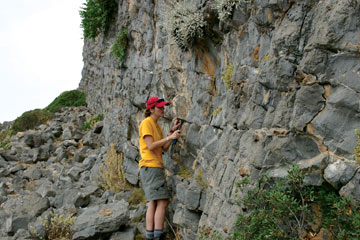|
NEWS NOTES
Toxic gas caused the Great Dying?
 Matthew Clapham |
| Catherine Powers, pictured here, and David Bottjer found evidence that helps point to the killer in the end-Permian extinction in ancient ocean sediments in Hydra, Greece. |
Life on Earth nearly ended 251 million years ago. The end-Permian mass extinction wiped out as much as 90 percent of all marine species as well as large numbers of terrestrial animals and plants. But what caused the catastrophe is still a matter of debate among scientists because a complete picture of all the events that led to the extinction has been missing.
A new study in the November Geology adds another piece to the puzzle. Catherine Powers and David Bottjer of the University of Southern California in Los Angeles compiled global fossil records of bryozoans, common marine organisms that live in a wide spectrum of environments, ranging from the deep oceans to near-shore waters. By studying the distribution and diversity of 396 bryozoan assemblages over about a 120-million-year time span, the team found that the organisms’ decline began millions of years before the mass extinction, suggesting that gradual environmental changes were responsible for the “Great Dying.” The find “argues against an extraterrestrial impact, such as an asteroid, being the killer,” which had been a popular hypothesis for the wide-scale extinction, says Lee Kump of NASA’s Astrobiology Institute and Pennsylvania State University in University Park, who was not involved in this research.
The records also revealed that those bryozoans that lived in deep waters were the first to go. Organisms living on ocean shelves and reefs followed gradually over time. This pattern hints that “something must have come from the deep ocean to kill these organisms,” Powers says.
Previous studies by Kump and others have suggested that rising hydrogen sulfide levels originating in the deep sea may have driven the extinction. The deep oceans were devoid of oxygen during the late Permian, creating a suffocating environment in which few organisms could survive. But this toxic brew was a comfortable home for hydrogen sulfide-producing bacteria, Kump explains. “Once they took over, things went from bad to worse as the waters went from anoxic to poisonous,” he says. As thriving bacteria produced more and more of the gas, it started spreading from deep to shallow water, which could explain the patterns that Powers and Bottjer observed in the late-Permian fossil record. “The hydrogen sulfide started killing off deep-water organisms first and gradually moved into shallow water, near-shore settings,” Powers says.
Indeed, researchers have found remains of specific photosynthetic bacteria, an indicator that hydrogen sulfide spread up into the ocean surface in the late Permian. “These bacteria need light, so they must have been in shallow water, but they also require hydrogen sulfide,” Kump says. “When you find chemical remains of these organisms, that’s a good indicator that hydrogen sulfide was present in shallow waters.”
Once the gas made it to the ocean surface, it could have escaped into the atmosphere, triggering terrestrial extinction, Kump says. “Poisonous clouds of hydrogen sulfide wafting around the continents would have killed animals and vegetation,” he says. The gas also could have damaged the planet’s ozone layer letting destructive radiation reach Earth’s surface.
Investigating the spatial distribution of the fossil record is a powerful tool to gain insight into causes and consequences of mass extinctions, Kump says. “I think that the frontier of geobiology is to look not only at time-dependent patterns of extinctions, but spatial patterns as well, because that tells you so much more.”

 Subscribe
Subscribe


